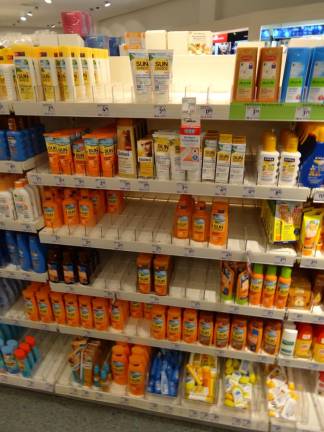Unraveling the Mystery of Sunscreen: A Guide to Understanding Your Options
Even those of us accustomed to translating the most arcane food and drug label terms may not be up-to-date on sunscreen logistics. Here’s a guide to a the most common.

Strolling through Manhattan may not be as relaxing as a day at the beach, but the sun’s rays remain just as potent. Therefore, it’s crucial to shield your exposed areas – such as the face, arms, hands, and possibly feet in open sandals – from its harmful effects. That’s where sunscreen comes to the rescue!
Even those of us accustomed to translating the most arcane food and drug label terms may not be up-to-date on sunscreen logistics. Here’s a guide to a the most common.
Start with a broad spectrum sunscreen regulated by the FDA. This protects you from both UVAs (Ultraviolet A) and UVBs, (Ultraviolet B).
UVA is a type of ultraviolet radiation emitted by the sun and is one of the three main types of ultraviolet rays. They have longer wavelengths and can penetrate deep into the skin, potentially causing premature skin aging, wrinkling, and other long-term skin damage.
UVB rays, on the other hand, have shorter wavelengths compared to UVA rays. However, when the skin is exposed to UVB rays, it can cause sunburn and can also contribute to the development of skin cancer over time.
Sunscreen is commonly available in various levels, with 30 and 50 being the most popular choices. However, you can find products with higher or lower levels of sun protection as well.
Next, the active ingredients, either minerals such as titanium dioxide and zinc oxide or chemicals such as avobenzone and homosalate. The difference? The mineral products form a visible protective barrier that sits on top of the skin which some people find icky. The chemicals, which convert the sun’s rays to heat that flows away, are smoother and invisible. On the other hand, they can be absorbed into the body and may be troublesome for people with allergies or sensitive skin.
Finally, FDA measures water resistance, the length of time the sunscreen stays protective when you’re in the water. Some sunscreens also claim to be sand resistant which means if you apply them and then sit in the sand the sand won’t cling to your skin. But there are no standards on this one.
Subsequently, manufacturers of these products often include additional terms on the label that are not regulated by the FDA. Among the popular ones are “clinically tested” and “hypoallergenic,” which may sound appealing but do not provide specific information about the tests conducted or the allergens considered.
If you’re in pursuit of an eco-friendly choice, keep an eye out for products labeled as “reef-friendly.” This designation ensures that the sunscreen contains no harmful ingredients that could hinder coral reproduction or shorten their lifespan, which is particularly crucial in locations like Australia compared to places like Jones Beach. Another indicator of environmentally conscious sunscreen is the term “biodegradable” on the label, as recognized by the Sierra Club, signifying the same coral-safe attributes.
Now that you have sorted out the logistics, it’s time to select the right product for you. If you decide on a lotion, a general guideline is to use about a teaspoon for each exposed body part. This includes your face, each arm, each leg, your chest, abdomen, extending all the way down to the top of your bikini line or board shorts for guys. Additionally, make sure to cover your back and the back of your neck.
Don’t overlook protecting the top of your ears and the upper part of your feet if you plan to go barefoot at the pool or beach. Taking these measures will ensure proper coverage and protection from the sun.
Cosmetically, lotions sit on top of the skin which may mean a layer of white on darker skin. Indeed, some beauty products cleverly integrate sunscreen into moisturizers and foundations. These convenient options not only provide sun protection but also apply smoothly and seamlessly blend into the skin. They effectively avoid leaving any sticky residue or unsightly white cast, making them a popular and practical choice for many.
Sprays, on the other hand are smooth and slick, but they may be absorbed through skin which can be a problem for people with allergies. However, if sprays work for you, spritz some into your hand and then apply to the appropriate areas. To avoid hitting your eyes or inhaling the spray mist, never ever spray directly on to your face.
Lastly, sprays may be flammable so keep them far away from any open flame like that grill you’ve fired up to make the burgers or hot dogs.